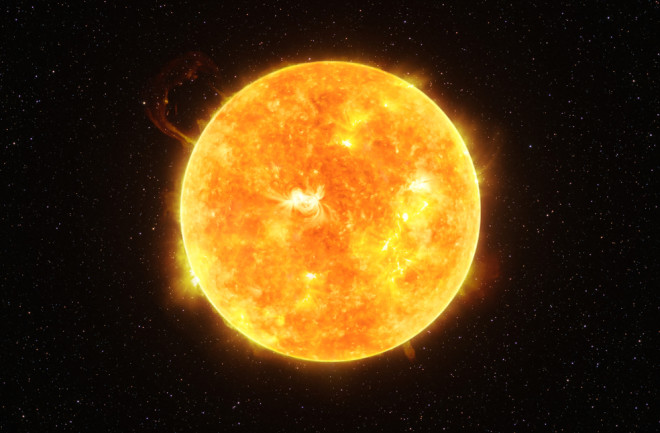The dinosaurs knew a smaller, dimmer sun than we do today. And we’re in the last legs of the viability of life on Earth. In about 500 million years, our sun will brighten to the point that it will trigger a runaway greenhouse effect on the Earth. The oceans will evaporate, locking in more heat in the atmosphere, which will cause even more evaporation, which will heat up the planet more, leading to an out-of-control feedback loop.
While today, we know our parent star as the source of light and warmth throughout the solar system, enabling life to arise and thrive on our planet. But things aren’t guaranteed to always be so peachy. Indeed, there are a variety of ways that the sun can extinguish all life on Earth.
UV Rays and Magnetic Fields
Let’s start with the simplest: ultraviolet (UV) radiation. UV radiation is an energetic form of light, with wavelengths shorter than visible light but longer than X-rays. The ozone layer absorbs most of the UV radiation pumped out by our sun every second, but it lets through some significant ranges in wavelengths.
Left unprotected, exposure to UV radiation can in mild cases lead to tanning or a nasty sunburn. Continued exposure leads to melanoma, a potentially deadly form of skin cancer. Without our ozone layer, the sun would blast us with even higher energy UV rays, which could decimate life on Earth (and may have been responsible for at least one extinction event).
Read More: A Sun's Eye View of the Solar System
Our atmosphere and magnetic field also protect us from another aspect of the sun: its occasional angry outbursts. The powerful magnetic fields of the sun can sometimes tangle up on themselves, building up energies until they finally snap like overstretched rubber bands. When they do, they release that pent-up energy in a burst of X-rays. Following that flare, the sun sometimes hurls a blob of its own atmosphere out into space, a furious storm of charged particles and overwhelming electromagnetic forces.
Our magnetic field deflects most of those forces, but at high enough energies the blast, known as a coronal mass ejection, just rudely shoves its way through. So far the most ferocious blast on record, which occurred in 1859, simply messed with telegraph wires. But that’s only a fraction of what the sun is truly capable of.
The Sun and Time
Besides the ever-present rain of UV radiation and occasional flare-up of even deadlier radiation, the other weapon the sun can wield is time. Slow, inexorable time. The problem is that the sun is slowly getting hotter and brighter as it ages. To live, the sun must fuse hydrogen in its core, with each reaction emitting just a tiny bit of energy. But that fusion reaction leaves behind helium.
Over the course of hundreds of millions of years, that helium builds up in the core, getting in the way of efficient hydrogen fusion reactions. To compensate for that contamination and maintain a stable state, the sun must burn hydrogen at a furious rate. As the fusion rate goes up, the temperatures in the core climb. Higher core temperatures mean higher everything temperatures, and as time goes on the sun slowly swells and brightens.
As it brightens and our oceans dry up, the out-of-control feedback loop begins. The oceans won’t be able to lubricate the mechanisms of plate tectonics, and our crust will lock in place. Without plate tectonics, carbon won’t be pulled out of the atmosphere. It will simply pile and pile on top of itself, building thick layers of atmosphere.
We will, in essence, become a copy of Venus. Life may cling to some miserable existence in some shadowed region, but the prospects are slim.
The Red Giant
But even if life does manage to survive the brightened sun, it certainly won’t survive what’s to come next. At the end of our sun’s life, too much helium will build up in the core. It will push the hydrogen fusion into a shell surrounding it. With the fusion displaced from the core, the entire atmosphere of the sun will swell to never-before-seen sizes.
Our star will become a red giant. Scientists aren’t exactly sure how big the red sun will become. It will certainly swallow Mercury and Venus whole. If the outer edges of its atmosphere reach the orbit of the Earth, it will devour our planet as well, with the solid bulk of our home – and everything on it – dissolving in the sun’s plasma in a matter of minutes.
If we’re lucky, our atmosphere will blow away, and our crust and mantle will melt from the intense heat. All that will remain of our planet will be our core of iron and nickel, a ruined husk orbiting a dying star.
While this future may seem grim, our advances in space exploration may provide us with the right resources to escape the red giant and continue life in the outer solar system.
